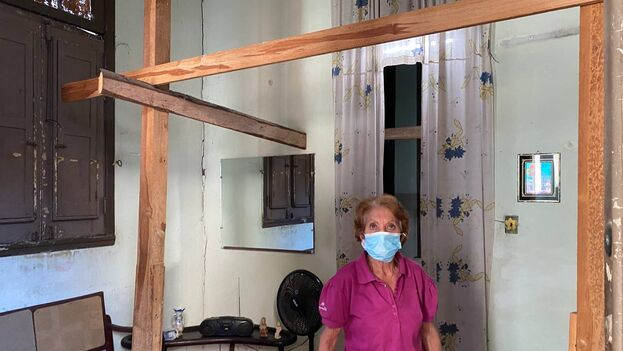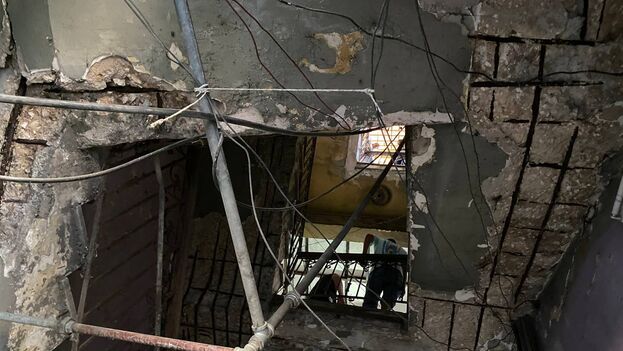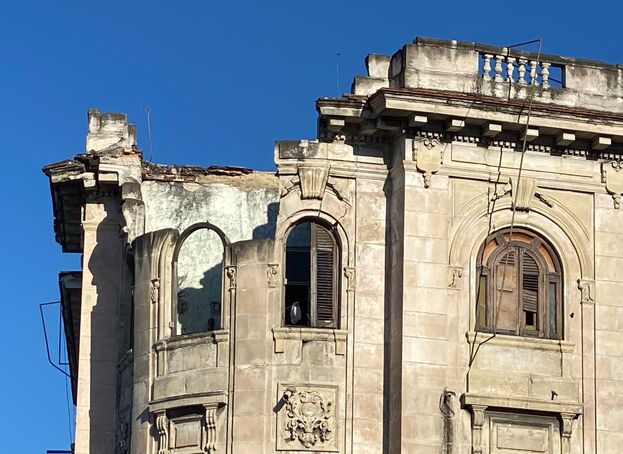
América de Jesús Prada bent over and over again to fill the water bottles that she had placed in front of two other ladies’ buckets that were also full of water. The building’s cistern has been dry for almost a month, and when they bring the tanker truck that supplies them, they have to rush to store as much water as possible.
The woman has been living for 54 years on the top floor of the building marked with number 909, located at the intersection of Infanta and Carlos III streets, in Centro Habana. One of her neighbors, sitting on the stairs, waits patiently for her turn while she complains that there is hardly a “trickle” from the sink and that it is almost time “to go to the kitchen to start dinner.”
Water, however, is not the biggest problem for the inhabitants of this building. The worst thing is to endure the passing of the years with the anguish of living in the “uninhabitable.” América says that she has had to give up living with her children and her grandson who, in the face of so much danger, found it necessary to leave the house and that now they are “lent out” living in other homes. “This here has no solution, every now and then there are partial collapses that make us lose sleep,” she laments.

The last one was on September 5th, when a part of the roof fell in the common area of the building. “The firefighters, Government, and Housing, Demolitions & Shelter officials came. They all continued to come all that week, but now, after the moment passed, no one else has come.”
América is concerned that her life will “end in tragedy” because of the poor condition of all the roofs. “That day of the last collapse there had been some five children sitting under the roof that fell. They did not get hurt because they had come inside just moments before,” she recalls. “They are always sitting in the common area or on the stairs, which are in very bad condition. The other day I fell when I was going up because there are missing parts and I stumbled, also every time it rains, another piece falls off.”
Prada points out every hole in the ceiling, every beam, the sunken parts of the floor that she never walks over as she opens the door to her apartment. “Inside here they had to write down everything, the ceilings are falling apart, the walls are cracked. I have gone to see the Housing and Shelters and they told us that this building has been listed for demolition since 1972,” she complains. “In the end, it is being demolished by itself with us inside it and they do not come up with a solution,” explains América, who is tired of “going there and returning with no answers at all” to get something that the officials responsible for the area should solve.
The “most difficult part” is at night: she finds it difficult to fall asleep due to fear of a collapse and she has had to find a method with which to feel more secure. “At bedtime I put an armchair over the bed right on top of the pillow and so at least I save my head, which is the most serious thing. Anyway, I hardly sleep at all, fearing that a piece of the roof will fall on me.”
América has never been able to make arrangements on her own because she can barely pay her daily expenses. “I worked for 33 years and my retirement is 1,700 pesos. Now, that is very little, everything is very expensive, I cannot even fix a window here.”
A difficult moment for the residents of 909, known in the neighborhood as “the avenues building,” is when they announce that a hurricane is approaching the Cuban capital. América says that before the imminent arrival of a hurricane, the Government has never evacuated them to safer places and that each one is organized to go to a relative’s house. “Most of the time I go to my sisters’ house. Then I return, always with the fear of arriving and finding some ruins.”

The bottle with Prada water has been filled and it is the neighbor’s turn who has waited all this time on the stairs. The woman, who prefers not to identify herself, confesses to this newspaper that though she shares her fear with her roommate at bedtime, she has almost adapted already, nine years after moving in. “At first, if I slept for two hours it was a lot. Now I got used to it a bit, and when dust or pebbles from the ceiling fall on me when I am in bed, I get up all nervous, but I dust off and continue to sleep on the other side. In terror, but I fall asleep again.”
The woman resists the distant possibility of going to a State shelter. “They have nowhere to put us because there is no capacity, but I prefer a thousand times to be here than to live in a shelter. I don’t like living with people I don’t know. In addition, you lose your privacy and the security of keeping safe the few belongings you have.”
In the midst of all the disaster, a neighbor is painting one of the windows of her apartment green. She carries the paint container in one hand and the brush in the other. She climbs on a chair and retouches the frame while she comments that she lost half of her roof once a brigade sent by the Government arrived, supposedly to repair a part that had collapsed on the outside. She now lives like this: half the house under a roof and the other half, under the sky.
Translated by Norma Whiting
____________
COLLABORATE WITH OUR WORK: The 14ymedio team is committed to practicing serious journalism that reflects Cuba’s reality in all its depth. Thank you for joining us on this long journey. We invite you to continue supporting us by becoming a member of 14ymedio now. Together we can continue transforming journalism in Cuba.
